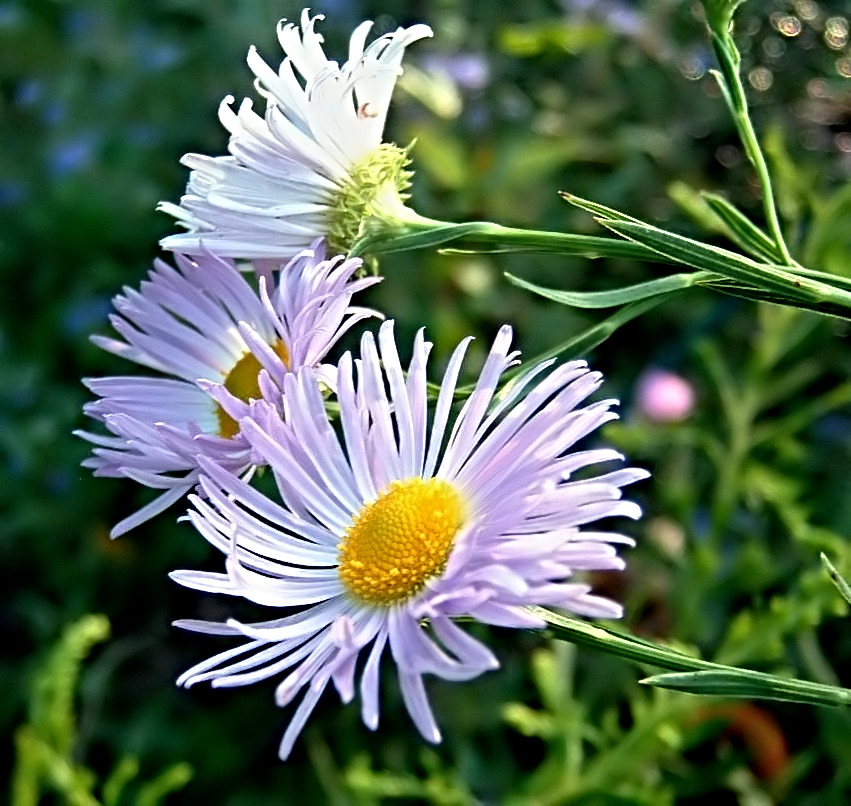Boltonia is a tall, late-season blooming perennial. It is a North American native wildflower that is often grown in gardens. It is a good choice for a colorful background plant in flower borders.
Boltonia is a bushy, strongly upright plant covered with a profusion of small yellow-centered white, pink, or blue daisies. It blooms from late summer to late autumn. The flowers resemble Michaelmas daisies.
Boltonia is a genus of plants that includes 14 species. Boltonia asteroides is the species grown in gardens. Other species can be grown in wildflower gardens or meadows.

Get to know Boltonia
- Plant type: Perennial
- Growing Zones and range: Zones 3 to 7
- Hardiness: Hardy to -35°F (-37°C); cold hardy perennial but foliage may die back in winter in cold regions
- Height and width: 4 to 6 feet (1.2-1.8m) tall; 3 to 4 feed (.9-1.2m) wide
- Foliage: Tall, mounded plants with gray-green willow-like foliage
- Flowers: Small daisy flowers 3/4-inch across
- Flower colors: White, pink, or blue with yellow centers
- Bloom time: Late summer to late fall
- Uses: Plant in mixed borders or with ornamental grasses, native gardens, Boltonia is deer-resistant
- Common name: Boltonia, Bolton’s Aster
- Botanical name: Boltonia asteroides
- Family: Asteraceae (Compositae)
Where to plant Boltonia
- Boltonia grows best in full sun but will tolerate very light shade.
- Grow Boltonia in humus-rich, moist, well-drained soil. Dry soil produces smaller plants.
- Boltonia prefers a soil pH of 5.5 to 7.
Boltonia uses and companions
- Grow Boltonia in a border or wild garden, or for cut flowers.
- Use Boltonia in the back of a border.
- Good Boltonia garden companions include Joe-Pye weed, Autumn Joy sedum, asters, chrysanthemums, black-eyed Susans, and fall-blooming plants.

When to plant Boltonia
- Set established plants in the garden in spring after the last frost.
- Sow seed indoors or outdoors after the last frost in spring.
- Divisions can be set in the garden in spring.
Planting and spacing Boltonia
- Sow Boltonia in evenly prepared garden soil.
- Sow seed indoors in six-packs or flats using a sterile seed-starting mix. Start seeds indoors in a bright location or under fluorescent light.
- Sow seeds 1/8 inch deep; lightly cover the seeds.
- Space Boltonia 3 to 4 feet (.9-1.2m) apart.
How to water and feed Boltonia
- Moderate water is best especially early in growth. Boltonia is drought tolerant when mature.
- Feed Boltonia lightly; side dress with an all-purpose fertilizer.
Boltonia care
- Mulch around Boltonia to spread splashing soil which can cause disease.
- Thin Boltonia to remove some stems in early summer; this will encourage stronger plants. Boltonia often needs staking.
- Deadhead spent flowers; flowers left on the plant will drop seed and the plant will quickly naturalize in the garden.
- Trim away dead foliage at the end of the bloom season or in spring to keep plants from becoming straggly.
- Divide Boltonia every 3 to 4 years.
- Boltonia is generally pest and disease-free. Avoid wetting the foliage; wet foliage can host fungal diseases.
Boltonia propagation
- Divide oversized clumps in spring. Plants generally need division every 3 to 4 years.
- Take cuttings in early summer.
- Allow flowers to dry on the plant if you want to collect seed for replanting.
- Seed collected from cultivars is unlikely to produce plants like its parents.
- Boltonia seeds germinate in 7 to 8 weeks at 60°F (15°C).
Boltonia varieties to grow
- Boltonia asteroides is a tall shrubby perennial 4- to 6-feet tall with narrow blue-green leaves and masses of 3/4 inch-wide daisies; flowers are white, pink, or pinkish purple with yellow centers; the cultivar ‘Snowbank’ hA white flowers.
- Boltonia asteroides var. latisquana ‘Pink Beauty’ has pale lilac-pink flowers and grows to 5 feet tall.















